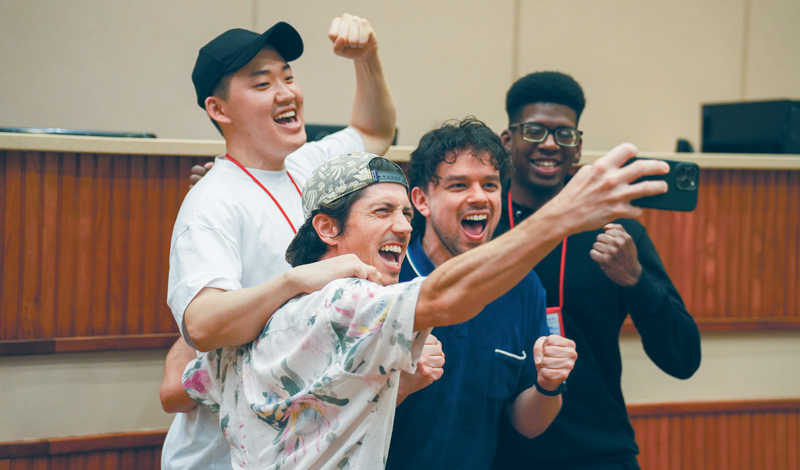Academy members should:
• be district through national youth leaders.
• have their own copy of The Wisdom of the Lotus Sutra, vol. 2.
• read the assigned material prior to each meeting.
DECEMBER SYLLABUS
The Wisdom of the Lotus Sutra, vol. 2, pp. 125–80
Part Five: “The Parable of the Phantom City” Chapter
• The Eternal Bond of Mentor and Disciple
Part Six: “Prophecy of Enlight-enment for Five Hundred Disciples” and “Prophecies Conferred On Learners and Adepts” Chapters
• The Voice-hearers Awaken
Supplementary Materials:
• The Lotus Sutra and Its Opening and Closing Sutras, pp. 154–98
• The Record of the Orally Transmitted Teachings, pp. 72–81
PARABLES
The Parable of the Phantom City
In the Lotus Sutra, Shakyamuni Buddha expounds the truth to which he awakened. In “Expedient Means,” the second chapter, only his disciple Shariputra understands the Buddha’s explanation. Shakyamuni in the next few chapters conveys various similes and parables, and his voice-hearer disciples respond with their own parable to affirm their understanding. In the seventh chapter, to awaken even more people to the truth, Shakyamuni shares the well-known Parable of the Phantom City, which goes like this:
A group of travelers go on a journey to search for a place with rare treasures. Their wise, experienced leader knows the route well. But halfway through the long, treacherous journey, the travelers lose heart and want to turn back. Seeing this, the leader conjures a city where they can rest and regain their spirits. Once everyone is refreshed, the leader wipes out the city and encourages them to continue on to the treasure land.
In this parable:
• wise, experienced leader = the Buddha
• travelers = the Buddha’s disciples
• phantom city = the expedient means the Buddha uses to lead people to Buddhahood
• treasure land = the one true vehicle of Buddhahood
This parable illustrates how the Buddha uses expedient means of the three vehicles to lead people to the one vehicle of Buddhahood, also known as “replacing the three vehicles with the one vehicle.”
—Prepared by the SGI-USA Study Department
DEEP DIVE
How the Phantom City Applies to Us
Ikeda Sensei: To view kosen-rufu as a point when an ideal has been attained is not without meaning. But I wanted to emphasize the importance of the spirit to spread Buddhism. We must not think of the “journey,” the process of achieving this ideal, as just a means. Those who make this mistake, using others as mere tools to achieve some end, may repeat the mistakes of revolutionary movements of the past that produced innumerable tragedies. …
To advance, we have to set up “phantom cities” in the form of targets. But on a deeper level, efforts to proceed toward and reach these “phantom cities” are themselves the actions of the Buddha. And the arena for these endeavors is itself the “treasure land.” …
Developing the state of life to delight in working hard for kosen-rufu, to view challenging circumstances as opportunities to create even more good fortune and to further expand our state of life prove that the world of Buddhahood is shining in our lives. …
We need to earnestly and steadfastly challenge ourselves to achieve goals. Resolving to overcome all obstacles, we must open a path forward. When we look back later, we will see that these moments, while perhaps trying, were in fact the most fulfilling and rewarding times of our lives. They will be a treasury of golden memories, great scenes in the eternal drama of our lives throughout the past, present and future. (WLS-2, 146–47)
KEY CONCEPTS
Revealing Our True Identity
In the Lotus Sutra’s eighth and ninth chapters, the “Prophecy of Enlightenment for Five Hundred Disciples” and “Prophecies Conferred on Learners and Adepts,” the voice-hearer disciples awaken to their true identities. They realize that they have always been bodhisattvas striving alongside their mentor. Ikeda Sensei says:
When the voice-hearers look at themselves, they realize that, as ordinary people from time without beginning, they have always been one with the Buddha. At one with the mentor, they are carrying out bodhisattva practice toward the goal of kosen-rufu. The essential teaching reveals to the beings in the assembly this profound aspect of their lives. (WLS-2, 168–69)
—Prepared by the SGI-USA Study Department
WISDOM INTO ACTION
Actualizing Our Boundless Potential

Alex Jones
San Diego
Q: What points from studying in Ikeda Wisdom Academy have you applied to your daily life, your SGI activities or in supporting others?
I recently went back to school for a major career shift, and I’m also working full time while taking on leadership responsibilities within the SGI.
In our September Ikeda Wisdom Academy meeting, we had a conversation about each individual’s boundless potential. Knowing that theoretically versus actualizing it in our lives is totally different. As I take on various endeavors, rather than limit myself, I think about how to expand my capacity. I want to give my all to work, school, SGI activities and more. I am prioritizing chanting daimoku and studying Buddhism to build a life condition that isn’t swayed by any obstacles.
As I learn to trust myself and my abilities, I can do the same with members I am supporting, especially the younger women who are stepping up in their Buddhist practice.
Trusting their capabilities, I want to give them more opportunities in our SGI activities. By supporting them, I feel I’m helping to empower each person to see their own full potential. I try to encourage them to feel in their own way a sense of mission and purpose in their lives and in the SGI.
Looking Forward: February 2024 Syllabus
The Wisdom of the Lotus Sutra, vol. 2, pp. 183–211
Part Seven: “Teacher of the Law” Chapter
• Teachers of the Law Live Among the People
You are reading {{ meterCount }} of {{ meterMax }} free premium articles

